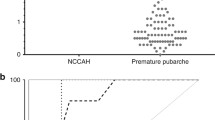Abstract
The aim of our study was to assess the frequency of 21-hydroxylase deficiency, a cause of congenital adrenal hyperplasia (CAH), in incidentally discovered asymptomatic adrenal masses (incidentalomas) and to compare the prevalence of this enzymatic disorder in monolateral (M) and bilateral (B) forms. Twenty-seven patients with incidentalomas (12 M and 15 B) and 16 sex and age-matched controls (C) received synthetic adrenocorticotropin (ACTH, 250 μg iv). Plasma 17-OHprogesterone (17-OHP) and Cortisol were collected in basal conditions and after 30, 60, 90 minutes. Basal plasma 17-OHP in C [1.25±0.15 (0.61) ng/ml, mean±SE (SD)] was not significantly different from that in patients with M [0.85±0.13 (0.44) ng/ml] or B [0.94±0.23 (0.90) ng/ml] incidentalomas. After ACTH, 17-OHP levels significantly (p<0.05) increased in C, in M and B incidentalomas. However, the rise in plasma 17-OHP in C both in terms of peak [2.5±0.28 (1.1) ng/ml] and of AUC values [174+16 (64) ng/ml/min] was significantly lower than that observed in M [peak 6.32±1.66 (5.7) ng/ml, p<0.01; AUC 410±111 (385.5) ng/ml/min, p<0.01] and in B [peak 8.84±1.98 (7.65) ng/ml, p<0.001; AUC 613±149 (579.3), ng/ml/min, p<0.001] incidentalomas. Individual data indicated that while 17-OHP response to ACTH in C never reached 5 ng/ml (cut-off for normal response), 16 out of 27 patients with incidentalomas (59.2%) exceeded this value. Moreover, the abnormal response was more frequently observed in B (66.6%) than in M (50%) incidentalomas. Basal and stimulated plasma Cortisol did not differ among the three groups. In conclusion, our data indicate that in adrenal incidentalomas the endocrine pattern of 21-hydroxylase deficiency is very common and that this enzymatic defect is more frequent in bilateral than in monolateral lesions.
Similar content being viewed by others
References
Osella G., Terzolo M., Borretta G., Magro G., Ali A., Piovesan A., Paccotti P., Angeli A. Endocrine evaluation in incidentally discovered adrenal masses (incidentalomas). J. Clin. Endocrinol. Metab. 79: 1532, 1994.
Ambrosi B., Peverelli S., Passini E., Re T., Ferrario R., Colombo P., Sartorio A., Faglia G. Abnormalities of endocrine function in patients with clinically “silent” adrenal masses. Eur. J. Endocrinol. 132: 422, 1995.
Reincke M., Nieke J., Krestin P., Saeger W., Allolio B., Winkelmann W. Preclinical Cushing’s Syndrome in adrenal “incidentalomas”: comparison with adrenal Cushing’s Syndrome. J. Clin. Endocrinol. Metab. 75: 826, 1992.
Jockenhovel F., Kuck W., Hauffa B., Reinhardt W., Benker G., Lederbogen S., Ulbricht Th., Reinwein D. Conservative and surgical management of incidentally discoverd adrenal tumors (incidentalomas). J. Endocrinol. Invest. 15: 331,1992.
Kobayashi S., Seki T., Nonomura K., Gotoh T., Togashi M., Koyanagi T. Clinical experience of incidentally discovered adrenal tumor with particular reference to cortical function. J. Urol. 150: 8, 1993.
Turton D.B., O’Brian J.T., Shakir K.M.M. Incidental adrenal nodules: association with exaggerated 17-hydroxyprogesterone response to adrenocorticotropic hormone. J. Endocrinol. Invest. 15: 789, 1992.
Gourmelen M., Pham-Huu-Trung M.T., Bredon M.G., Girard F. 17-hydroxyprogesterone in the cosyntropin test: results in normal and hirsute women and in mild congenital adrenal hyperplasia. Acta Endocrinol. (Copenh.). 90: 481, 1979.
Chrousos G.P., Loriaux D.L., Mann D., Cutler G.B. Late-onset 21-hydroxylase deficiency is an allelic variant of congenital adrenal hyperplasia characterized by attenuated clinical expression and different HLA haplotype associations. Horm. Res. 16: 193, 1982.
Rosenwaks Z., Lee P.A., Jones G.S., Migeon C.J., Wentz A.C. An attenuated form of congenital virilizing adrenal hyperplasia. J. Clin. Endocrinol. Metab. 49: 335, 1979.
New M.I., Dupont B., Pang S., Pollack M., Levine L.S. An uptake of congenital adrenal hyperplasia. Recent Prog. Horm. Res. 37: 105,1981.
Gutai J.P., Kowarski A.A., Migeon C.J. The detection of the heterozygous carrier for congenital virilizing adrenal hyperplasia. J. Pediatr. 90: 924,1977.
Krensky A.M., Bongiovanni A.M., Marino J., Parks J., Tenore A. Identification of heterozygote carriers of congenital adrenal hyperplasia by radioimmunoassay of serum 17-OH progesterone. J. Pediatr. 90: 930, 1977.
Weil J., Bidlingmaier F., Sippel W.G., Butenandt O., Knorr D. Comparison of the two tests for heterozygocity in congenital adrenal hyperplasia (CAH). Acta Endocrinol. (Copenh.). 91: 109, 1979.
New M.I., Lorenzen F., Lerner A.J., Kohn B., Oberfield S.E., Pollack M.S., Dupont B., Stoner E., Levy J. D., Pang S., Levine L.S. Genotyping steroid 21-hydroxylase deficiency: hormonal reference data. J. Clin. Endocrinol. Metab. 57: 320, 1983.
Baskin H.J. Screening for late-onset congenital adrenal hyperplasia in hirsutism or amenorrhea. Arch. Intern. Med. 147: 847, 1987.
Fiet J., Gueux B., Gourmelen M., Kuttenn F., Vexiau P., Couillin P., Pham-HuuTrung MI, Villette JM., Raux-Demay MC, Galons H., Julien R. Comparison of basal and adrenocorticotropin-stimulated plasma 21-deoxycortisol and 17-hydroxyprogesterone values as biological markers of late-onset adrenal hyperplasia. J. Clin. Endocrinol. Metab. 66: 659,1988.
Racz K., Pinet F., Marton T., Szende B., Glaz E., Corvol P. Expression of steroidogenic enzyme messenger ribonucleic acids and corticosteroid production in aldosterone-producing and “non-functioning” adrenal adenomas. J. Clin. Endocrinol. Metab. 77: 677,1993.
Symington T. Functional pathology of the human adrenal gland. The Williams and Wilkins Co., Baltimore, 1969, p. 151.
Dobbie J.W. Adrenocortical nodular hyperplasia: the ageing adrenal. J. Pathol. 99: 1, 1969.
Takayama K., Ohashi M., Haji M., Matsumoto T., Mihara Y., Kumazawa J., Kato K-l. Adrenocortical tumor in a patient with untreated congenital adrenocortical hyperplasia owing to 21-hydroxylase deficiency: characterization of steroidogenesis. J. Urol. 140: 803, 1988.
Jaresch S., Kornely E., Kley H-K. Schlaghecke R. Adrenal incidentaloma and patients with homozygous or heterozygous congenital adrenal hyperplasia. J. Clin. Endocrinol. Metab. 74: 685, 1992.
Author information
Authors and Affiliations
Rights and permissions
About this article
Cite this article
Giampaolo, B., Brogi, G., Vivaldi, M.S. et al. 17-hydroxyprogesterone response to ACTH in bilateral and monolateral adrenal incidentalomas. J Endocrinol Invest 19, 745–752 (1996). https://doi.org/10.1007/BF03347878
Accepted:
Published:
Issue Date:
DOI: https://doi.org/10.1007/BF03347878




